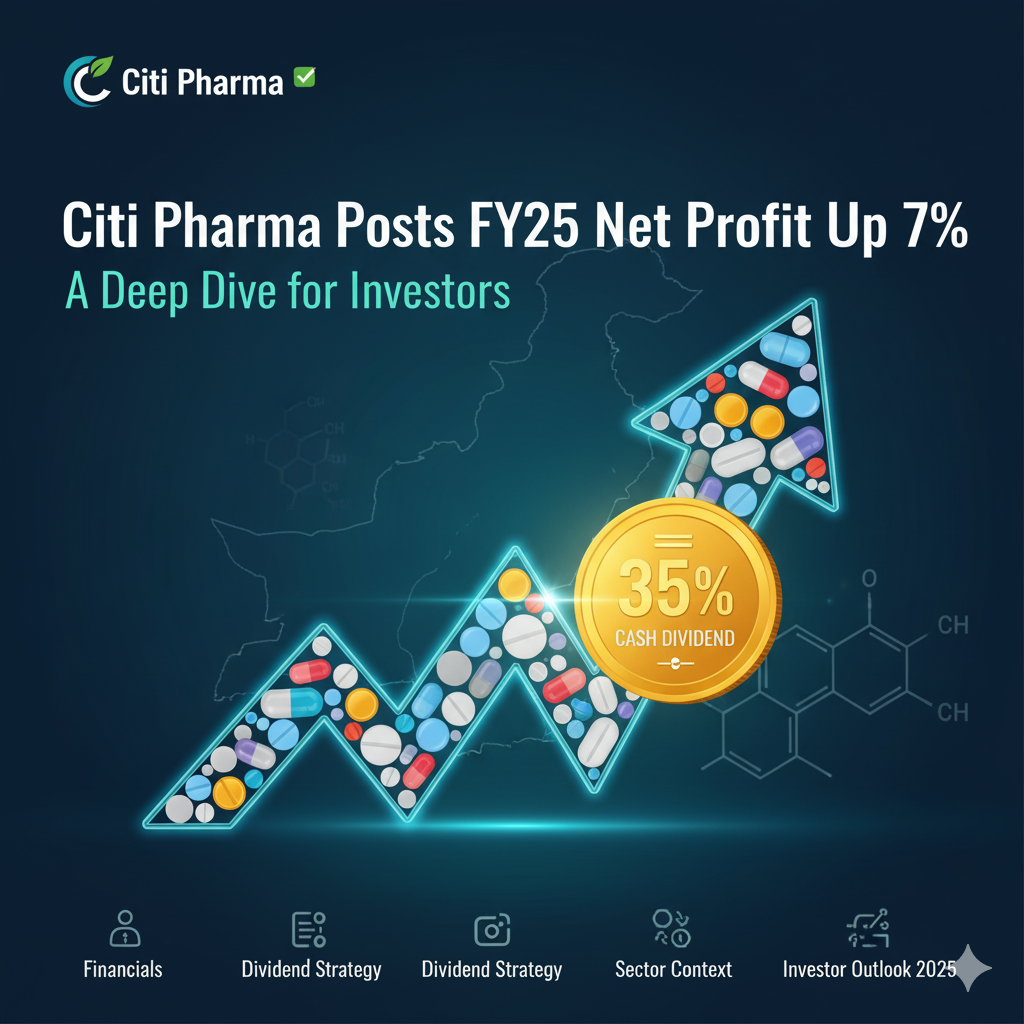Introduction
In a strong performance for the Pakistan pharmaceutical sector, Citi Pharma Limited (CPHL) announced a 7% year-on-year increase in net profit for fiscal year 2025. Alongside, the company revealed a 35% cash dividend for its shareholders. This development not only underscores Citi Pharma’s financial health but also signals confidence about future growth prospects and investor returns in a competitive industry landscape.
According to market sources, Citi Pharma’s profit after tax stood at PKR 892.04 million in FY25, with sales reaching approximately PKR 13.15 billion, marking a 6% increase year over year.
This blog analyzes the details, strategic moves, potential challenges, and broader sector dynamics behind Citi Pharma’s results.
Financial Highlights: FY25 in Numbers
Revenue & Profit Growth
- Net profit (PAT) in FY25: ~ PKR 892.04 million, up 7% from the prior year.
- Sales increased ~6% to PKR 13.15 billion.
- The company’s profit growth outpaced top-line growth, signaling potential improvements in cost control, margin expansion, or operational efficiencies.
Dividend Strategy
- Citi Pharma is paying a 35% cash dividend, a significant return to shareholders and an indicator of management’s confidence in sustained cash flows.
Expansion Moves & Strategic Initiatives
Beyond these core results, the company is actively expanding its footprint:
- Citi Pharma has launched a veterinary health subsidiary, Citi Veterinary Limited (CVL), entering the animal health market with 32 products (including vaccines).
- CVL targets a turnover of PKR 1,500 million (Rs 1.5 billion) in FY25–26 and plans to scale to PKR 10 billion within three years.
- Plans are underway to establish Pakistan’s first dedicated veterinary Active Pharmaceutical Ingredient (API) plant in FY26–27, which could raise margins to ~25%.
- Additionally, Citi Pharma is exploring new markets overseas: it has announced plans to build a manufacturing plant in Iraq, marking an international expansion step.
Why Citi Pharma’s Performance Matters
Sign of Strength in a Challenged Sector
The pharmaceutical sector in Pakistan faces pressures from import costs (APIs, raw materials), currency volatility, regulatory changes, and competition. Achieving double-digit profit growth even in a modest top-line environment signals solid operational execution.
Rewarding Shareholders
A 35% cash dividend is generous in the context of Pakistani listed companies and provides immediate returns to investors. It also sends a message that management expects stable or growing cash flows.
Diversification Strategy
Their push into veterinary health and international expansion suggests leadership is trying to reduce dependence on domestic human pharma revenues. If successful, these moves can buffer against domestic headwinds and open large growth avenues.
Margin Uplift via Backward Integration
The plan to build a veterinary API plant is strategically important: producing raw materials in-house cuts import costs, reduces margin erosion, and ensures supply stability, particularly under currency fluctuation risk.
Risks, Challenges & Watch Points
- Execution Risk: Launching new verticals (veterinary, API) demands expertise, regulatory approvals, and supply chain setup, which could lag initial projections.
- Capital Requirements: Growth initiatives and foreign expansion require capital; balancing investment with dividends and working capital is key.
- Regulatory & Quality Compliance: Pharma is heavily regulated. Any lapses in quality, licensing, or drug approvals can derail plans.
- Currency & Import Dependencies: Raw materials and APIs are often imported, so currency depreciation, import tariffs, or supply disruptions remain major risks.
- Market Competition: In both human and veterinary pharma, competition from multinational and generic firms can pressure pricing and margins.
Implications & Sector Context
- Investor Confidence Boost: Strong results and a generous dividend can attract local and foreign investors, improving liquidity and valuations.
- Benchmark for Peers: Citi Pharma’s performance might set a benchmark for other Pakistani pharma companies to pursue diversification and growth beyond core lines.
- Sectoral Growth Signal: The pharma sector may be entering a period of consolidation, innovation, and scale as companies search for sustainable margins.
- Export Orientation & Regional Ambition: The Iraq plant signals the ambition to export rather than depend solely on the domestic market.
Conclusion
Citi Pharma’s 7% net profit growth in FY25 and the 35% cash dividend declaration represent more than just a good result — they reflect strategic steadiness in a volatile industry. While expansion into veterinary services and international markets introduces risk, it also offers growth pathways that many peer firms have yet to pursue.
For investors and industry watchers, the key will be execution: converting plans into revenue and ensuring margins hold in the face of macro pressure. If Citi Pharma succeeds, it could become a shining example of how Pakistani pharma firms evolve from domestic players into regional competitors.







